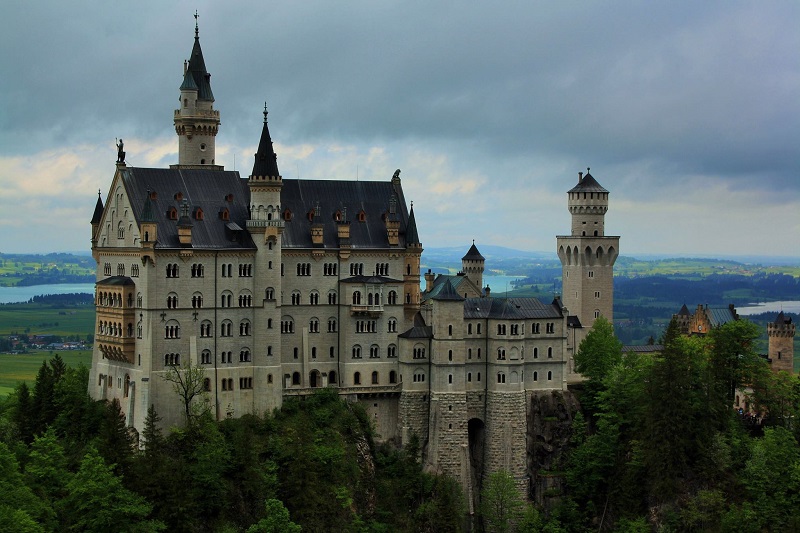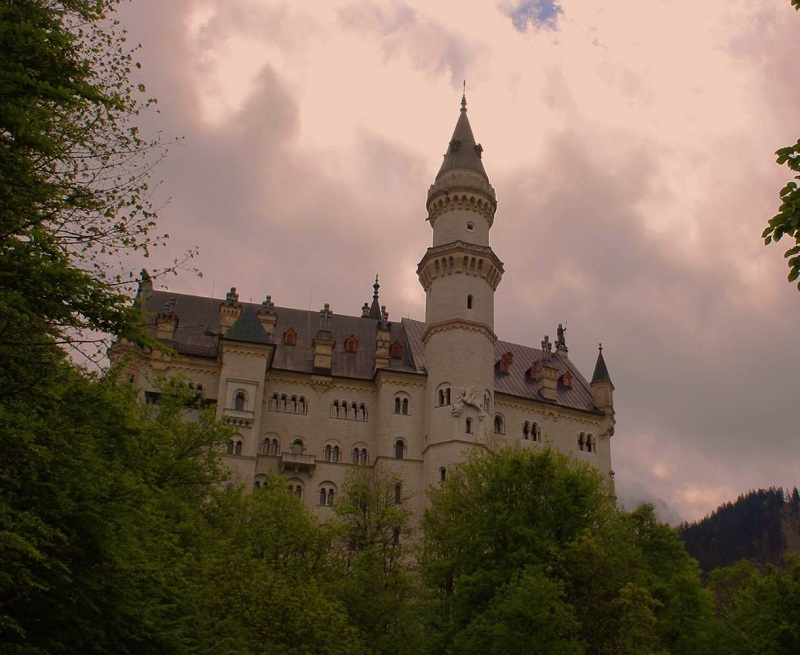Neuschwanstein Castle
Contents |
[edit] Introduction
Neuschwanstein Castle, located on a hill in southwest Bavaria, Germany, was commissioned by King Ludwig II of Bavaria as his personal retreat and homage to the composer Richard Wagner. Completed in 1886, the castle was designed in the Romanesque Revival style that became popular in the late-19th century.
Three castles originally overlooked the villages of the Schwangau municipality, dating back to the Middle Ages. Having lived there as a child, King Ludwig, in his desire to construct his fantasy castle, tore down the ruins of the original structures. He commissioned a new building using his own funds, which sent him into debt, and instructed the architect Eduard Riedel to design a castle based on the operas of Wagner and the stage sets of Christian Jank.
With its towers and turrets that appear to have been inflated like a giant bouncy castle, and multiple levels and tessellations that invoke the Grimm Brothers fairy tales, Neuschwanstein is an iconic example of Romanticism and remains a recognisible symbol of Germany.
[edit] Design and construction
King Ludwig took a keen personal interest in the design of the castle; however, the construction process was more problematic than had been foreseen, due to its mountain-ridge location.
The design incorporates Romanesque shapes such as bi- and triforia window openings and semi-circular arches, with Byzantine and Gothic influences such as slim towers and upward-pointing lines. The elongate building is characterised by its numerous towers, gables, balconies and turrets.
Construction began in September 1869, after the ruins of the medieval castle were completely demolished, despite original intentions to incorporate them into the new building. The cellar was completed in 1872 and topping out was achieved in 1880.
The castle was built using conventional brick, marble and white limestone mined from a nearby quarry and lifted to the site using a steam crane. With costs escalating to around 6.2 million marks, Ludwig insisted that tight deadlines be met, with up to 300 workers being engaged for periods of night-work with oil lamps.
By the end of 1882, it was mostly complete, save for the keep, and Ludwig began living there to oversee the remaining work.
The interior design features ornately-decorated rooms such as Ludwig's personal suite, a Singer's Hall, and Grotto, based on German legends that had inspired Wagner's operas. Despite originally being designed to include more than 200 rooms, just 15 rooms and halls were ever completed.
[edit] Post-completion
King Ludwig died in 1886, having lived in the castle for only 172 days. With debts piling up, work stopped on the keep and only minor works continued until 1891.
Immediately after Ludwig's death, the authorities decided to open the castle to the public in an attempt to recoup costs. Whilst the building was lambasted as kitsch by the critics of the time, it is now appreciated as a fine example of European historicism and significant for being one of the last big palace-building projects of the 19th century.
The castle was made state property after 1918, when Bavaria became a republic. It is now managed by the Bavarian Palace Department.
Due to its isolated location, it was used by the Nazis during the Second World War as a storage depot for artworks stolen from occupied France. As the war drew to an end, the SS planned to blow up the castle to prevent it falling to the enemy, although this did not in the end happen.
The castle's global fame increased drastically when it was chosen as the model for the Sleeping Beauty Castle for Disneyland which opened in 1955. It also featured in the popular children's film 'Chitty Chitty Bang Bang'. Today, 1.3 million tourists visit the castle every year, making it one of the most popular attractions in Europe.
There is continuous monitoring of movement in the foundations, and the sheer rock walls must be repeatedly secured. The harsh climate of the exposed location has had a detrimental effect on the limestone façades, which will require section-by-section renovation over the next few years.
[edit] Find out more
[edit] Related articles on Designing Buildings Wiki
- Architectural styles.
- Boldt Castle, Heart Island.
- Brandenburg Gate.
- Building of the week series.
- Buildings in film.
- Casa Mila.
- Cologne Cathedral.
- Eiffel Tower.
- Edinburgh Castle.
- Fallingwater.
- Florence Cathedral.
- Leaning Tower of Pisa.
- Monument and context.
- Nineteenth century building types.
- Nottingham Castle.
- Palace of Westminster.
- Polite architecture.
- Sagrada Familia.
- St. Basil's Cathedral.
- Waldspirale.
[edit] External resources
- Neuschwanstein - Official site
Featured articles and news
Retired firefighter cycles world to raise Grenfell funds
Leaving on 14 June 2025 Stephen will raise money for youth and schools through the Grenfell Foundation.
Key points for construction at a glance with industry reactions.
Functionality, visibility and sustainability
The simpler approach to specification.
Architects, architecture, buildings, and inspiration in film
The close ties between makers and the movies, with our long list of suggested viewing.
SELECT three-point plan for action issued to MSPs
Call for Scottish regulation, green skills and recognition of electrotechnical industry as part of a manifesto for Scottish Parliamentary elections.
UCEM becomes the University of the Built Environment
Major milestone in its 106-year history, follows recent merger with London School of Architecture (LSE).
Professional practical experience for Architects in training
The long process to transform the nature of education and professional practical experience in the Architecture profession following recent reports.
A people-first approach to retrofit
Moving away from the destructive paradigm of fabric-first.
International Electrician Day, 10 June 2025
Celebrating the role of electrical engineers from André-Marie Amperè, today and for the future.
New guide for clients launched at Houses of Parliament
'There has never been a more important time for clients to step up and ...ask the right questions'
The impact of recycled slate tiles
Innovation across the decades.
EPC changes for existing buildings
Changes and their context as the new RdSAP methodology comes into use from 15 June.
Skills England publishes Sector skills needs assessments
Priority areas relating to the built environment highlighted and described in brief.
BSRIA HVAC Market Watch - May 2025 Edition
Heat Pump Market Outlook: Policy, Performance & Refrigerant Trends for 2025–2028.
Committing to EDI in construction with CIOB
Built Environment professional bodies deepen commitment to EDI with two new signatories: CIAT and CICES.
Government Grenfell progress report at a glance
Line by line recomendation overview, with links to more details.
An engaging and lively review of his professional life.
Sustainable heating for listed buildings
A problem that needs to be approached intelligently.
50th Golden anniversary ECA Edmundson apprentice award
Deadline for entries has been extended to Friday 27 June, so don't miss out!
CIAT at the London Festival of Architecture
Designing for Everyone: Breaking Barriers in Inclusive Architecture.
Mixed reactions to apprenticeship and skills reform 2025
A 'welcome shift' for some and a 'backwards step' for others.





























